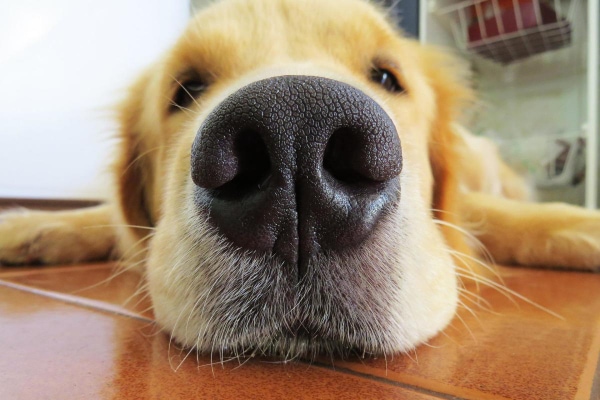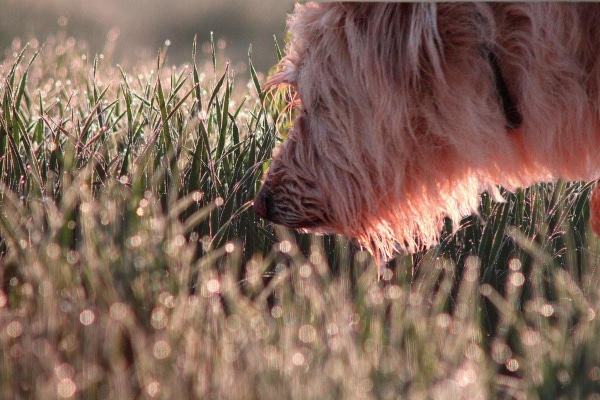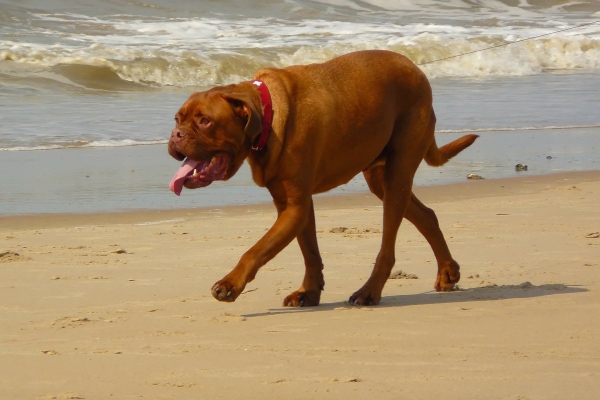Continued Slow Nose Bleed in Dog
A dog nose bleed can be upsetting (and messy). To help you feel prepared should your dog's nose ever start bleeding unexpectedly, integrative veterinarian Dr. Julie Buzby explains how to stop a nose bleed at home and discusses 13 causes of dog nose bleeds.

Nose bleeds in people can be common occurrences. If you've ever accidentally been hit in the nose, you may have experienced a nose bleed. And some people may develop them in the wintertime due to the presence of dry air. But what does it mean when your dog has a nose bleed? And how do you stop a dog nose bleed?
What is a dog nose bleed?
As the name would indicate, a nose bleed involves blood or bloody nasal discharge coming from your dog's nose. The technical term for a nose bleed is "epistaxis." Depending on the underlying cause, the blood can come out of one or both nostrils. The source of the blood may be the nostrils, nasal passages, or nasopharynx (back of the throat adjacent to the nasal passages).
Nose bleeds can be very mild and short-lived, or they can be intense and result in severe blood loss. Some nose bleeds will not be very noticeable until the dog sneezes and little droplets of blood come out of his or her nostrils. Other times the blood may be steadily pouring out onto the floor.
How do you treat a dog's nose bleed at home?
If you notice your dog is having a nose bleed, the first question on your mind is probably how to make it stop. You might not have to worry about doing much if there is only a drop or two of blood. But if there is more blood, follow these steps to help stop a dog's nose from bleeding:
1. Remain calm
Try to bring your furry friend away from any noisy, busy areas. Look for somewhere quiet, especially if you're at home. Stress and excitement can raise your dog's blood pressure and make him or her bleed more.

2. Apply an ice pack to the bridge of the nose
Grab an ice pack (or a Ziploc bag filled with ice will do in a pinch), wrap it in paper towels or a washcloth and then gently apply it to the bridge of your pup's nose. The cold will slow the bleeding by constricting local blood vessels.
Word of warning—if you have a short-nosed dog, ensure that you are not making it hard for your dog to breathe by obstructing the nostrils with the ice pack.
3. Avoid sticking anything in your dog's nose
Don't stick anything up your dog's nose to stop the bleeding. I know it might be tempting because people do it for their nose bleeds. But stuffing gauze, tissues, etc. up a dog's nose is irritating and may make him or her sneeze, which can worsen the bleeding.
4. Follow up with your vet
If your dog is bleeding heavily, the bleeding lasts longer than a few minutes without showing signs of stopping, or your dog is showing any other signs of illness or injury, your may need to make an emergency vet visit to get the bleeding under control and find and treat the underlying cause. Even if you get the bleeding to stop and your dog seems fine, it is usually still a good idea to check in with your vet during his or her regular business hours. That way your vet can run any needed diagnostic to help get to the bottom of why your dog had a bloody nose.
What can cause nose bleeds in dogs?
There are times when the cause for a dog's nose bleed can be very obvious and times when it is not. If your pup has a nose bleed after he or she went excitedly careening across the room and ran face-first into the wall or doorframe, you can probably put two and two together. However, there are other situations where the cause may not be so clear. That is when it will be up to your veterinarian to help you look for it. Some of the causes of a nose bleed in dogs include:
#1: Trauma
We might as well start with trauma because, according to a 2007 study in the Journal of the American Veterinary Medical Association (JAVMA), trauma and nasal tumors are the top two causes of nose bleeds in dogs.
Sometimes trauma can be as simple as your excitable canine companion not being able to "hit the brakes" fast enough when doing zoomies in the house or not noticing that the clear sliding glass door was closed and hitting his or her head. Examples of more intense trauma include falling from great heights or being hit by a car. If the nose was traumatized in these examples, a nose bleed is very likely to occur.

#2: Nasal tumors or cancer
The other top cause of epistaxis in the 2007 JAVMA article was nasal tumors. Nasal adenocarcinoma, a locally aggressive kind of cancer, is the most common type of nasal tumor. It can affect one or both sides of the nose.
This means a dog nose bleed on one side may be more indicative of a local tumor (or other local issue) instead of other body-wide causes of nose bleeds that would affect both sides.
There are also many different non-nasal cancers that can increase the risk of epistaxis. These include:
- Lymphoma in dogs
- Hemangiosarcoma in dogs
- Multiple myeloma
- Leukemia
#3: Medications and drug reactions
The use of non-steroidal anti-inflammatory drugs (NSAIDs) may increase the risk of nose bleeds because they can inactivate blood clotting factors. This makes it easier for bleeding to occur from the delicate mucous membranes within the nose. There are several different NSAIDs that are made specifically for dogs (e.g., firocoxib, carprofen). Thankfully, nose bleeds tend to be a rare side effect of these drugs.
Adverse reactions to other medications are also rare but possible. Certain hormone therapies and chemotherapeutic drugs have been known to cause nose bleeds. A specific antibiotic drug class known as the sulfonamides (aka sulfa drugs) can also result in epistaxis.
#4: Toxin exposure
There are any number of toxic chemicals that have been known to affect an animal's blood clotting abilities. This in turn could lead to nose bleeds as well as bleeding from other locations in the body.
Rat poison (i.e. rodenticide) works by decreasing a rodent's ability to clot blood, leading to fatal internal hemorrhaging. Unfortunately, many commercially available rodenticides can cause the same terrible death in dogs and cats. It is important to keep these poisons far out of reach of your dog.
#5: Foreign bodies
It is possible for a foreign object to find its way up your pup's nose. In the Western United States, spiky plant material known as grass awns can be a big problem. Some examples of grass awns include foxtails and cheatgrass. These sharp, stiff pieces of grass are barbed in such a way that pulling them out of a dog's nasal passages can be extremely painful. It is no wonder they can irritate the tissue and cause nose bleeds.

#6: Dental disease
In the average dog skull, there is a thin plate of bone that separates the nasal cavity from the oral cavity below. When periodontal disease (i.e. dental disease in dogs) is present, it can lead to significant bone infection or even bone loss beneath the surface of the gums.
Thus, dental disease affecting the teeth in the upper portions of the mouth can lead to problems within the nasal cavity. One such example is an oronasal fistula, a tiny open communication between the nasal cavity and the oral cavity. This communication can result in infection and nose bleeds.
#7: Fungal infections
While transmission of certain bacterial and viral infections through nasal inhalation of particles is possible, the inhalation of fungal spores tends to be much more devastating. Fungal infections such as Aspergillus fumigatus, Blastomyces dermatitidis, and certain Penicillium species can invade the nasal cavity as well as other parts of the upper and lower respiratory tracts.
The end results of these fungal infections are pneumonia-like symptoms, nose bleeds, and various other clinical signs. It can take months for a dog to undergo treatment, and some infections may be lifelong.
#8: Tick-borne illnesses
Tick-borne diseases in dogs such as Ehrlichia canis and Babesia gibsoni can cause several clinical symptoms such as fever, lameness, and lethargy. Because these types of infections can affect a dog's blood-clotting abilities, tick-borne diseases can also cause nose bleeds.
#9: Autoimmune diseases
If a dog has an autoimmune disorder, it means that the immune system is mounting an inappropriate response to the dog's own cells. In other words, immune system complexes that would normally attack foreign invaders are attacking normal parts of the dog's body instead.
Patients with immune-mediated thrombocytopenia (ITP) suffer from low platelet counts. This is because the immune system attacks and destroys platelets, a type of cell that helps to form blood clots. Without enough platelets to help the blood clot, nose bleeds are possible.

#10: Bone marrow disorders
Your dog's bones do a lot more than just form his or her skeleton. In the center of the bones, there is a spongy, vascular tissue called bone marrow. Among other things, bone marrow is responsible for the creation of platelets. It houses large precursor cells called a megakaryocytes, which eventually break down to create hundreds of little platelets.
Certain diseases and drugs that inhibit or suppress the bone marrow can lead to overall decreased platelet production, thus increasing the risk of epistaxis.
#11: Hyperviscosity syndrome
Hyperviscosity syndrome occurs when there are very high levels of protein in a dog's blood. It is difficult to know the true reason this happens. But certain diseases like amyloidosis (i.e. a condition where the body deposits a protein called amyloid in various locations) and monoclonal gammopathies (i.e. a condition where the body makes too much of one type of immune system protein called immunoglobulins) are thought to be factors.
When there is too much protein in the blood, there isn't enough room for the fluid component (i.e. plasma) so the blood becomes very thick or viscous. The increased pressure from this thicker fluid results in blood vessels rupturing, which leads to blood loss. Nose bleeds are one way the body may lose blood.
#12: Blood clotting disorders
Blood clotting is controlled by the interplay of numerous proteins known as coagulation factors. If one of those factors is deficient, it can cause a bleeding disorder.
Various inherited conditions can negatively impact clotting ability. For example, hemophilia A results in a deficiency of coagulation factor VIII. This causes anything from a mild nose bleeds to extreme blood loss. As another example, Doberman Pinschers are at an increased risk of inheriting von Willebrand disease. This condition causes platelets to lose the protein that makes them "sticky" enough to form blood clots. Affected dogs are at a higher risk of abnormal bleeding.
Clotting issues can also be acquired. When there is serious damage to the internal organs—due to things like infection, inflammation, or heat stroke in dogs—the body can enter a state called disseminated intravascular coagulation (DIC). In DIC, the clotting system, which normally regulates how clots form and break down, goes haywire. Thus, a dog with DIC might suffer from clots in all the wrong places or bleeding from anywhere, especially the nose.

#13: Liver failure or kidney failure
When important internal organs like the liver and kidneys can no longer function properly, there can be problems that lead to bleeding. The liver creates the majority of the coagulation factors, so understandably, liver disease in dogs can lead to decreased coagulation factor production. Without coagulation factors, blood cannot clot and the dog is prone to spontaneous bleeding like nose bleeds.
Chronic kidney failure in dogs may lead to high blood pressure (i.e. hypertension in dogs). The increased pressure in the vessels may make the capillaries more fragile and therefore, prone to rupturing. This can cause bleeding in various locations, including the nose.
What other symptoms go along with a nose bleed?
As you can see from this list, there are many different reasons a dog may get a bloody nose. Sometimes you might only see the bloody nasal discharge. Other times there are additional clinical signs such as:
- A firm swelling that appears over the bridge of the nose or next to the eyes, eye discharge or a protruding third eyelid, and/or more frequent sneezing in dogs with a nasal tumor.
- Pale gums, black/tarry stools, unexplained bruising under the skin, difficult or heavy breathing, dog is breathing fast, and/or becoming a pot-bellied dog if there are issues with clotting factors or platelet numbers.
- Sudden onset sneezing and pawing at the nose in dogs who have a nasal foreign body.
- Bad breath, old dog losing teeth, dog tooth abscesses and/or oral pain if the dog has dental disease.
- Increased thirst in dogs, increased urination, vomiting, and/or weight loss in a dog with kidney disease.
If your dog is having nose bleeds, please also report any other symptoms to your vet. That will make it easier for your vet to get to the bottom of why the nose bleeds are happening.
What diagnostics might the vet run?
In addition to gathering your dog's history (including travel history, symptoms, etc.) and doing a complete physical exam, your vet may suggest several other tests. Often, he or she will start with some blood tests. This may include a complete blood count (CBC) and blood chemistry profile. These tests are a useful way to evaluate red blood cell and platelet numbers, measure proteins and globulins (for hyperviscosity syndrome), and look at liver and kidney enzyme levels. Urine testing is also a part of this minimum database of information.
Additionally, the vet may decide to run tick titers to look for the presence of tick-borne illnesses or coagulation tests to check for blood clotting issues or DIC. The vet might also suggest basic imaging like X-rays and ultrasound to look for evidence of cancer, fungal infections, and internal bleeding.
If the vet suspects a nasal tumor, he or she will probably recommend advanced imaging such as a CT and MRI. These modalities are better at detecting nasal tumors than X-rays alone. The vet also may suggest a thorough oral exam under general anesthesia (including dental X-rays) if he or she thinks dental disease may be contributing to the nose bleeds.
Some dogs will end up needing a rhinoscopy to figure out why they are having nose bleeds. Rhinoscopy is a procedure where the veterinarian inserts a special scope into the nasal cavity to look for signs of trauma, tumors, fungal infections, or foreign bodies. In some cases, the vet may decide to take biopsy samples during the rhinoscopy. However, you should be aware that local inflammation and the tendency for nasal tissue to bleed easily can make it hard to get good samples.

What is the treatment for nose bleeds?
Once your vet reaches a diagnosis, he or she will work with you to come up with a treatment plan. The vet will need to address issues like infections, inflammatory conditions, and organ damage with additional therapy. If the epistaxis resulted from the use of certain medications, the vet may advise you to stop giving those medications.
A dog with a nasal foreign body requires surgical removal of the offending object before it causes further damage. If there is a nasal tumor, the vet may recommend referral to a board-certified oncologist for surgery and/or radiation.
Your veterinarian may also recommend a Chinese herbal supplement called Yunnan Baiyao for dogs if your dog suffers from chronic nose bleeds. Yunnan Baiyao seems to have almost magical clotting properties.
What is the outlook for dogs with nose bleeds?
As you can imagine, the prognosis varies depending on why the dog is having nose bleeds. Most dogs with minor nose bleeds due to trauma or a mild infection have a very good prognosis. However, chronic illnesses like liver failure and kidney failure will have guarded to poor prognoses. Locally aggressive nasal cancers also carry a poor to grave prognosis, especially if left untreated.
Don't let nose bleeds get you down
I know it can be alarming to see your dog's nose suddenly dripping blood or to have him or her sneezing blood. But if your dog starts to have a nose bleed, remember to remain calm, apply ice to the bridge of the nose, and then get in contact with your vet.
There are a wide range of reasons for a nose bleed, and some are worse than others. Regardless of what the cause may be, work closely with your veterinarian and follow his or her advice. Together you can hopefully reduce or maybe even eliminate your dog's nose bleeds. That way you and your dog can keep enjoying life together without nose bleeds getting in the way.
Has your dog ever had a nose bleed?
Please share your experience below.
Source: https://toegrips.com/dog-nose-bleed/
0 Response to "Continued Slow Nose Bleed in Dog"
Post a Comment